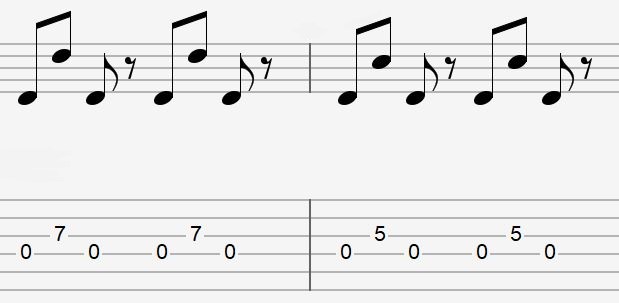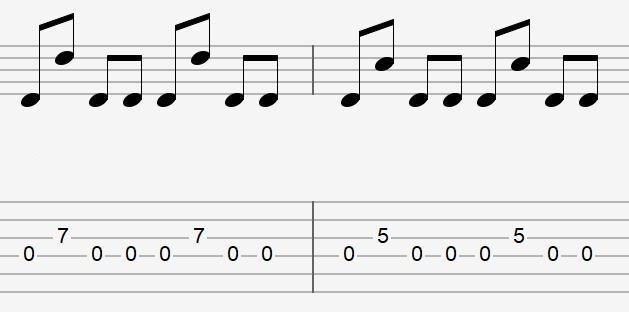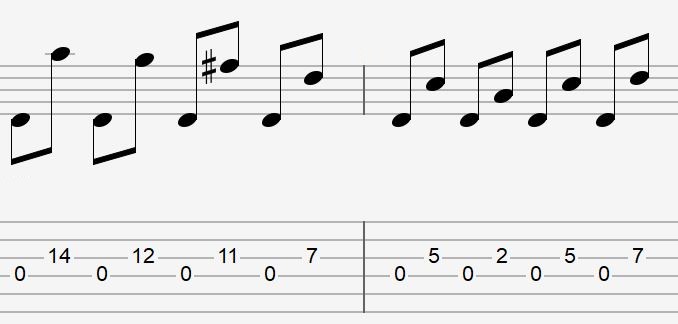Grade 4 Technical Focus: String Crossing
String crossing is a technique that involves playing notes separately on adjacent strings. The technique requires good picking accuracy and fluidity in order to cross between the strings cleanly and without any rhythming interferences. In the case of the Grade 4 study piece, “She Sells Sanctuary”, the string crossing is also integrated with some position shifts. In this Technical Focus we will break down the technique for both hands when working on crossing strings with position shifts.
EXERCISE 1
When starting with string crossing, the first thing you want to do is just establish the technique and the coordination between your left and right hands while doing so. In this exercise, we will take the 7th and 5th frets on the G string and the open D string to form the basis of what we’ll do. The rhythm of this is straight quarter notes. On the 1 and 3, you will be playing the open D string, this applies to both bars. On the 2 and 4 you will play the 7th fret on the G string (In the first bar) and the 5th fret on the G string (In the second bar). Take care when moving between the strings to ensure the volume of each note is consistent and the length of each note is the same.
EXERCISE 2
Sticking with the same notes, this time we will change up the rhythm slightly to give a different feel. We will switch the quarter notes for eighth notes with an eighth note rest. If you visualise this rhythm as straight eighths you will have:
“1 & 2 & 3 & 4 &”
In each bar, the open strings fall on the beat. The fretted notes fall on the “&” of 1 and 3. The eighth note rest falls on the “&” of 2 and 4:
“1 & 2 & 3 & 4 &”
Take care with the timing of the rest notes and remember that you will be picking the same open string twice either side of the rest note.
EXERCISE 3
Now we get into more complex open string rhythms. This exercise is straight eighth notes, but the fretted note has been moved to an offbeat to change the feel of the passage:
“1 & 2 & 3 & 4 &”
When playing patterns like this, you may benefit from using alternate picking to assist with the flow. The two most logical options would be to stick to strict alternate picking:
“1 & 2 & 3 & 4 &”
D U D U D U D U
Or, to downpick the open strings and up pick the fretted notes:
“1 & 2 & 3 & 4 &”
D U D D D U D D
EXERCISE 4
Position shifts can make cross string playing tricky. Instead of focusing on moving back and forth between a few notes that are in close proximity, when you start to move around the fretboard the coordination between your hands comes very much into focus.
For this example, we are sticking with a straight eighth note timing but on every “&” beat playing a different fretted note. The open strings fall on each beat.
The first bar fretted notes are all on the G string and descend from the 14th fret to the 12th, 11th and 7th fret. The second bar fretted notes start on the 5th fret before dropping down to the 2nd and then climbing back up to the 5th and ending on the 7th. It’s a good idea to familiarise yourself with the left hand movement by just playing the fretted notes. Take your time with the position shifts to ensure that you are hitting each note clearly and in time.
Once you are comfortable with the left hand motions, start to add the open D string into the piece. You will be able to use each open D string as a small window to move to the next fretted note. Start slow to make sure your hands are coordinated through this whole exercise.
EXERCISE 5
If we now combine different rhythms and position shifts we get a more complex approach to string crossing. While this may initially take a little getting used to, the rhythm that it follows is not as tricky as it initially seems:
“1 2 3 & 4”
For the most part it is just straight quarter notes with the third beat being split into two eighth notes. Each bar contains two position shifts. The fretted notes fall on beats 2 and 4 for each bar. In the first bar, the position shift is from the 14th to the 12th, the second bar position shift is from the 11th fret back up to the 12th, the third bar goes from the 7th fret down to the 5th and the final bar contains the trickiest position shift from the 2nd fret to the 12th. This is quite a big shift to perform. As with Exercise 4, it’s worth spending some time familiarising yourself with the order of the fretted notes as we are performing both ascending and descending shifts through out this whole piece. Take particular care with the 10 fret jump in the last bar, make sure you can move your hand at the right speed to not impact the flow when you add the open strings back in.
About the author
Leigh Fuge is a guitar teacher and professional musician based in South Wales. He works as a guitar teacher for MGR Music Tuition, runs his own successful tuition business, and fills his calendar as a session guitarist and journalist for several high profile guitar websites and publications. You can find professional guitar teachers like Leigh local to you by visiting https://mgrmusic.com/guitar-lessons.













